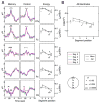Interactions between working memory and visual perception: an ERP/EEG study
- PMID: 17512216
- PMCID: PMC1974846
- DOI: 10.1016/j.neuroimage.2007.04.014
Interactions between working memory and visual perception: an ERP/EEG study
Abstract
How do working memory and perception interact with each other? Recent theories of working memory suggest that they are closely linked, and in fact share certain brain mechanisms. We used a sequential motion imitation task in combination with EEG and ERP techniques for a direct, online examination of memory load's influence on the processing of visual stimuli. Using a paradigm in which subjects tried to reproduce random motion sequences from memory, we found a systematic decrease in ERP amplitude with each additional motion segment that was viewed and memorized for later imitation. High-frequency (>20 Hz) oscillatory activity exhibited a similar position-dependent decrease. When trials were sorted according to the accuracy of subsequent imitation, the amplitude of the ERPs during stimulus presentation correlated with behavioral performance: the larger the amplitude, the more accurate the subsequent imitation. These findings imply that visual processing of sequential stimuli is not uniform. Rather, earlier information elicits stronger neural activity. We discuss possible explanations for this observation, among them competition for attention between memory and perception and encoding of serial order by means of differential activation strengths.
Figures





References
-
- Agam Y, Bullock D, Sekuler R. Imitating unfamiliar sequences of connected linear motions. Journal of Neurophysiology. 2005;94(4):2832–2843. - PubMed
-
- Agam Y, Galperin H, Gold BJ, Sekuler R. Learning to imitate novel motion sequences. Journal of Vision In press. - PubMed
-
- Arbib MA, Bonaiuto J, Rosta E. The mirror system hypothesis: From a macaque-like mirror system to imitation. In: Cangelosi A, Smith ADM, Smith K, editors. Proceedings of the 6th international conference on the evolution of language (EVOLANG6); World Scientific Publishing Company. 2006. pp. 3–10.
-
- Awh E, Anllo-Vento L, Hillyard SA. The role of spatial selective attention in working memory for locations: evidence from event-related potentials. Journal of Cognitive Neuroscience. 2000;12(5):840–847. - PubMed
-
- Awh E, Jonides J, Reuter-Lorenz PA. Rehearsal in spatial working memory. Journal of Experimental Psychology: Human Perception & Performance. 1998;24(3):780–790. - PubMed
Publication types
MeSH terms
Grants and funding
LinkOut - more resources
Full Text Sources

